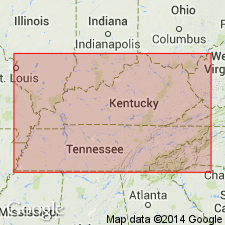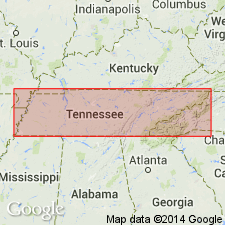
- Usage in publication:
-
- Bledsoe limestone
- Modifications:
-
- Named
- Dominant lithology:
-
- Limestone
- AAPG geologic province:
-
- Cincinnati arch
Summary:
Bledsoe limestone (new) is top bed of Clifton limestone in TN. Thickness ranges 0 to 32 feet. Overlies Newsom (Waldron) shaly clay and unconformably underlies Pegram limestone or Chattanooga shale. Same as Louisville limestone of IN. Age is Silurian (Niagaran).
Source: GNU records (USGS DDS-6; Reston GNULEX).

- Usage in publication:
-
- Bledsoe limestone
- Modifications:
-
- Areal extent
- AAPG geologic province:
-
- Cincinnati arch
Summary:
Pg. 269-270, fig. 80. Bledsoe limestone. In this report, all occurrences of post-Waldron Silurian strata in Central basin are called Bledsoe limestone. Thickness 18 feet at Bakers Station, 35 feet at Shackle Island, and 80 feet at Bransford, [central Tennessee]. Conformably overlies Waldron shale; unconformably overlain by either Pegram formation or Chattanooga shale. Age is Silurian (Niagaran).
Source: US geologic names lexicon (USGS Bull. 1200, p. 384).
For more information, please contact Nancy Stamm, Geologic Names Committee Secretary.
Asterisk (*) indicates published by U.S. Geological Survey authors.
"No current usage" (†) implies that a name has been abandoned or has fallen into disuse. Former usage and, if known, replacement name given in parentheses ( ).
Slash (/) indicates name conflicts with nomenclatural guidelines (CSN, 1933; ACSN, 1961, 1970; NACSN, 1983, 2005, 2021). May be explained within brackets ([ ]).

